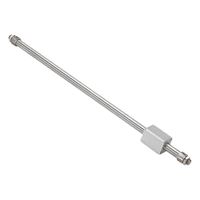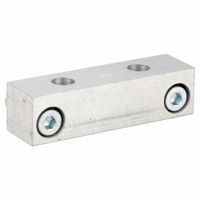Call +(254) 703 030 000 / 751 483 999 / 721 704 777
- Home
- Pneumatics
- Pneumatic Actuators
- Air Cylinders
- Rodless Air Cylinders
.....Read More
Frequently Asked Questions
What are rodless air cylinders used for?
Rodless air cylinders are used in various industrial applications where linear motion is required but space constraints or specific design requirements make traditional rod-style cylinders impractical. These cylinders provide linear motion without the need for an external piston rod, which allows for a more compact design and eliminates the risk of rod bending or buckling.
Key applications include:
1. **Material Handling**: Rodless air cylinders are ideal for moving materials along a production line, such as pushing, pulling, or lifting items. Their compact design allows for efficient use of space in automated systems.
2. **Packaging Machinery**: In packaging operations, these cylinders are used for tasks like sealing, cutting, and positioning packages. Their ability to provide precise and repeatable motion is crucial for maintaining consistency and quality.
3. **Conveying Systems**: They are used in conveyor systems to transfer products between different stages of production. The absence of an external rod allows for smoother and more reliable operation in tight spaces.
4. **Automated Assembly**: In assembly lines, rodless cylinders are used to position components accurately for assembly, welding, or inspection processes. Their design allows for easy integration into complex machinery.
5. **Printing and Textile Machines**: These cylinders are used to control the movement of print heads or textile materials, ensuring precise alignment and tension control.
6. **Door and Gate Automation**: Rodless air cylinders are used in automatic doors and gates, providing smooth and controlled opening and closing actions.
Overall, rodless air cylinders offer advantages such as reduced footprint, increased stroke length, and minimized risk of contamination, making them suitable for a wide range of industrial applications where space efficiency and precise linear motion are essential.
How do rodless air cylinders work?
Rodless air cylinders operate by using compressed air to move a piston within a sealed cylinder. Unlike traditional air cylinders, they do not have an external rod extending from the piston. Instead, the piston is connected to an external carriage or load-carrying mechanism that moves along the length of the cylinder.
There are three main types of rodless air cylinders:
1. **Cable Cylinders**: These use a cable or band that wraps around the piston and extends outside the cylinder. As the piston moves, the cable pulls the external carriage along.
2. **Magnetically Coupled Cylinders**: These have a magnet embedded in the piston and another magnet or magnetic material in the external carriage. The magnetic force keeps the carriage attached to the piston as it moves, allowing for a non-contact transfer of motion.
3. **Band Cylinders**: These feature a slot along the length of the cylinder, sealed by a flexible metal or plastic band. The piston is connected to the external carriage through this slot. As the piston moves, the band flexes to maintain the seal while allowing the carriage to move.
Rodless air cylinders are advantageous in applications requiring long strokes, as they eliminate the need for a long, unsupported rod. They also save space and reduce the risk of bending or buckling associated with long rods. These cylinders are commonly used in automation, material handling, and packaging industries, where precise and efficient linear motion is required.
What are the advantages of using rodless air cylinders?
Rodless air cylinders offer several advantages:
1. **Space Efficiency**: They are designed without an external piston rod, allowing for a more compact setup. This is particularly beneficial in applications with limited space.
2. **Longer Stroke Lengths**: Rodless cylinders can achieve longer stroke lengths than traditional rod-style cylinders without increasing the overall length of the cylinder assembly.
3. **Reduced Side Load**: The absence of an external rod minimizes side loading, which can lead to less wear and tear on the cylinder and associated components.
4. **Versatile Mounting Options**: They offer flexible mounting configurations, making them adaptable to various applications and orientations.
5. **Improved Load Handling**: Rodless cylinders can handle loads more effectively, as the load is directly connected to the moving carriage, reducing bending moments.
6. **Enhanced Sealing**: The design often includes better sealing mechanisms, reducing the risk of contamination and leakage.
7. **Cost-Effective**: By eliminating the need for additional support structures for long strokes, they can reduce overall system costs.
8. **Smooth Operation**: They provide smoother and more stable motion, which is ideal for applications requiring precise control.
9. **Reduced Maintenance**: With fewer moving parts exposed to the environment, maintenance requirements are typically lower.
10. **Safety**: The enclosed design reduces the risk of injury from exposed moving parts, enhancing workplace safety.
These advantages make rodless air cylinders suitable for a wide range of industrial applications, including material handling, packaging, and automation systems.
What is the difference between mechanically jointed and magnetically coupled rodless air cylinders?
Mechanically jointed and magnetically coupled rodless air cylinders are both types of pneumatic actuators used for linear motion, but they differ in their construction and operation.
Mechanically Jointed Rodless Air Cylinders:
1. **Construction**: These cylinders have a piston connected to an external carriage via a mechanical linkage or band that runs through a slot in the cylinder tube.
2. **Operation**: The piston moves inside the cylinder, and the mechanical linkage transfers this motion to the external carriage.
3. **Sealing**: The slot in the cylinder is sealed with a flexible band to prevent air leakage while allowing the mechanical linkage to pass through.
4. **Load Capacity**: They generally have higher load capacities due to the direct mechanical connection.
5. **Applications**: Suitable for applications requiring precise positioning and high load handling.
6. **Maintenance**: May require more maintenance due to wear and tear on the mechanical components and seals.
Magnetically Coupled Rodless Air Cylinders:
1. **Construction**: These cylinders use a magnetic coupling between the internal piston and the external carriage, with no physical connection.
2. **Operation**: The piston inside the cylinder is magnetically coupled to the carriage, moving it along the cylinder as the piston moves.
3. **Sealing**: The cylinder tube is completely sealed, as there is no slot or mechanical linkage passing through it.
4. **Load Capacity**: Typically have lower load capacities compared to mechanically jointed cylinders due to the reliance on magnetic force.
5. **Applications**: Ideal for clean environments and applications where contamination must be minimized, such as in food or pharmaceutical industries.
6. **Maintenance**: Generally require less maintenance due to fewer moving parts and no external seals.
In summary, mechanically jointed cylinders offer higher load capacity and precision, while magnetically coupled cylinders provide a cleaner, low-maintenance solution.
How do you select the right rodless air cylinder for an application?
To select the right rodless air cylinder for an application, consider the following factors:
1. **Load Requirements**: Determine the weight and type of load the cylinder will move. This includes static and dynamic loads, as well as any potential side loads.
2. **Stroke Length**: Identify the required stroke length, which is the distance the cylinder needs to move. Ensure the cylinder can accommodate this length without compromising performance.
3. **Mounting Options**: Consider the mounting configuration that best suits your application, such as end, side, or bottom mounting. Ensure compatibility with existing equipment.
4. **Speed and Cycle Time**: Determine the speed at which the cylinder must operate and the cycle time for each operation. This will influence the choice of cylinder size and type.
5. **Operating Pressure**: Check the available air pressure in your system and ensure the cylinder can operate efficiently within this range.
6. **Environmental Conditions**: Consider the operating environment, including temperature, humidity, and exposure to dust or chemicals. Choose materials and seals that can withstand these conditions.
7. **Precision and Repeatability**: Assess the level of precision and repeatability required for the application. Some cylinders offer higher accuracy and control.
8. **Space Constraints**: Evaluate the available space for installation. Rodless cylinders are ideal for applications with limited space due to their compact design.
9. **Cost and Maintenance**: Consider the initial cost, as well as long-term maintenance requirements. Opt for a cylinder that offers a balance between cost-effectiveness and durability.
10. **Manufacturer Support**: Choose a reputable manufacturer that offers technical support and after-sales service to ensure reliable operation and troubleshooting assistance.
By carefully evaluating these factors, you can select a rodless air cylinder that meets the specific needs of your application.
What maintenance is required for rodless air cylinders?
Maintenance for rodless air cylinders involves several key steps to ensure optimal performance and longevity:
1. **Regular Inspection**: Periodically check for any signs of wear, damage, or leaks. Inspect the cylinder body, seals, and connections for any visible issues.
2. **Lubrication**: Ensure that the cylinder is properly lubricated. Use the manufacturer-recommended lubricant to reduce friction and wear on moving parts. Some cylinders are designed to be maintenance-free and may not require additional lubrication.
3. **Seal Replacement**: Over time, seals can wear out and cause leaks. Regularly inspect and replace seals as needed to maintain efficiency and prevent air loss.
4. **Cleaning**: Keep the cylinder and its environment clean. Dust and debris can cause damage or interfere with the cylinder's operation. Use a clean, dry cloth to wipe down the cylinder and remove any contaminants.
5. **Alignment Check**: Ensure that the cylinder is properly aligned with the load it is moving. Misalignment can cause uneven wear and reduce the cylinder's lifespan.
6. **Pressure Check**: Verify that the air pressure supplied to the cylinder is within the manufacturer's specified range. Incorrect pressure can lead to inefficient operation or damage.
7. **Connection Inspection**: Check all air supply lines and connections for tightness and integrity. Loose or damaged connections can lead to air leaks and reduced performance.
8. **Performance Monitoring**: Monitor the cylinder's performance for any changes in speed, force, or smoothness of operation. Any deviations may indicate a need for maintenance or repair.
9. **Documentation**: Keep a maintenance log to track inspections, repairs, and replacements. This helps in identifying patterns and planning future maintenance activities.
By following these maintenance steps, you can ensure that rodless air cylinders operate efficiently and have a longer service life.
What types of mounting hardware are available for rodless air cylinders?
Rodless air cylinders can be mounted using various types of hardware, each suited for specific applications and installation requirements. The primary types of mounting hardware available for rodless air cylinders include:
1. **Foot Mounts**: These are brackets attached to the ends of the cylinder, allowing it to be mounted on a flat surface. They provide stability and are ideal for applications where the cylinder needs to be secured in a fixed position.
2. **Clevis Mounts**: This type of mount allows for pivoting motion, making it suitable for applications requiring angular movement. Clevis mounts are typically used in conjunction with a clevis pin to secure the cylinder.
3. **Trunnion Mounts**: Trunnion mounts are pivoting mounts located at the center or ends of the cylinder. They allow the cylinder to pivot around the trunnion axis, accommodating angular misalignment and providing flexibility in motion.
4. **Flange Mounts**: These mounts involve a flange attached to the cylinder, which can be bolted to a surface. Flange mounts are robust and provide a secure attachment, suitable for heavy-duty applications.
5. **End Cap Mounts**: These mounts are integrated into the end caps of the cylinder, allowing for direct attachment to a surface or structure. They are compact and save space, making them ideal for tight installations.
6. **Slide or Guide Mounts**: These mounts incorporate linear guides or slides, providing additional support and precision in linear motion applications. They are used when high accuracy and reduced deflection are required.
7. **T-Slot Mounts**: These mounts utilize T-slots on the cylinder body, allowing for adjustable and flexible positioning. They are versatile and can be used in various configurations.
Each type of mounting hardware offers unique benefits and is chosen based on the specific requirements of the application, such as load capacity, motion type, and installation space.


